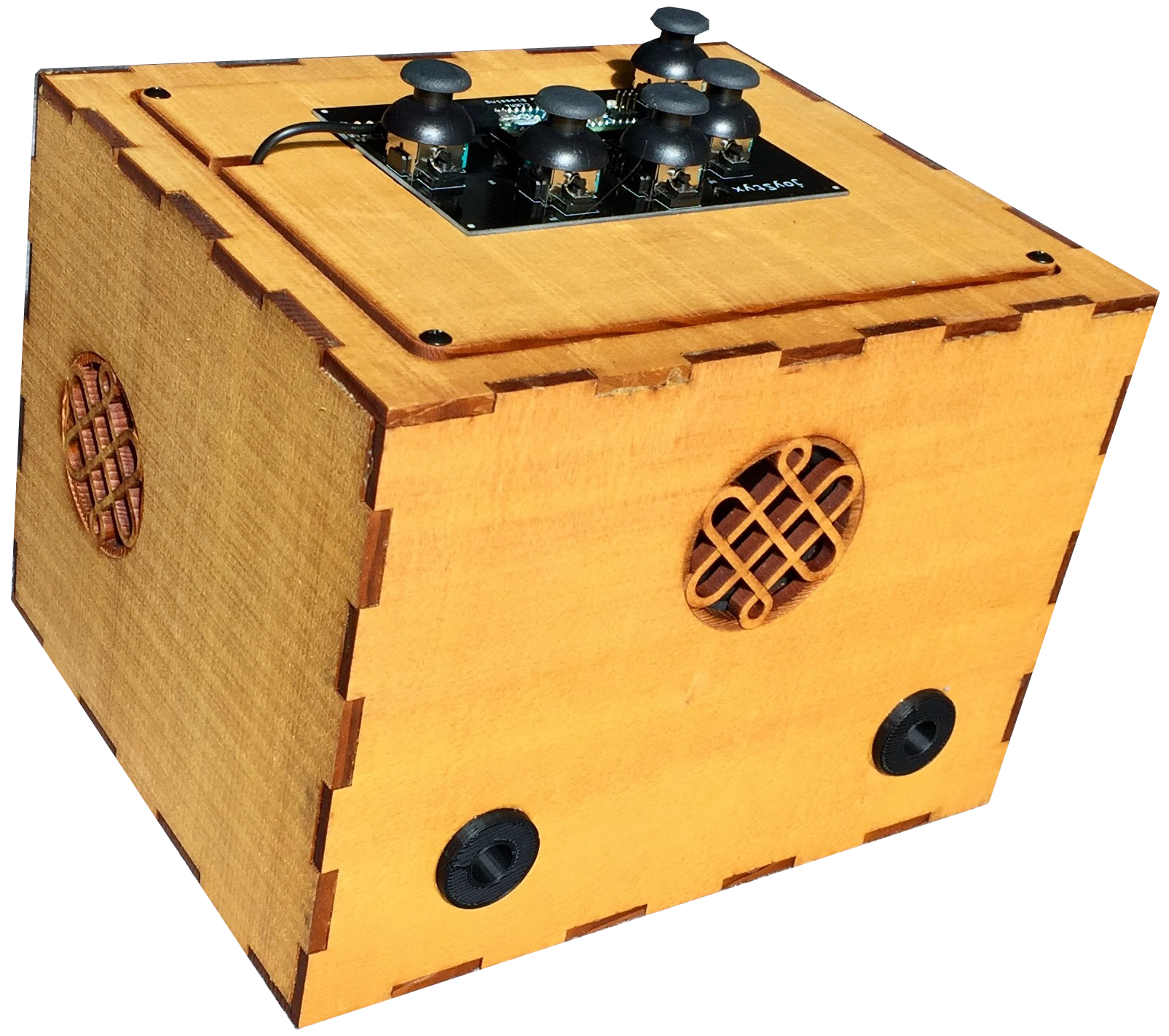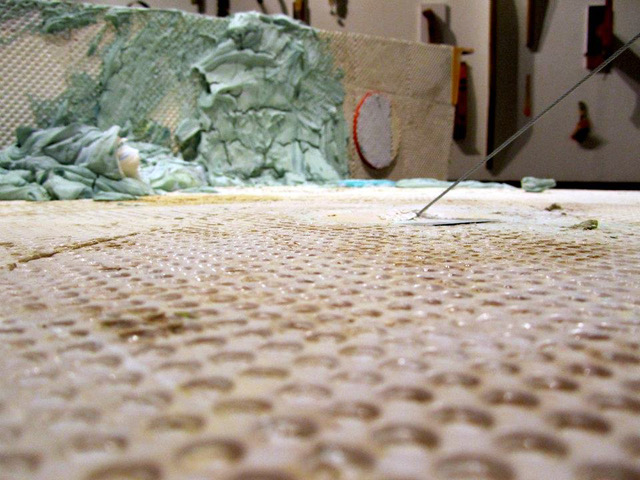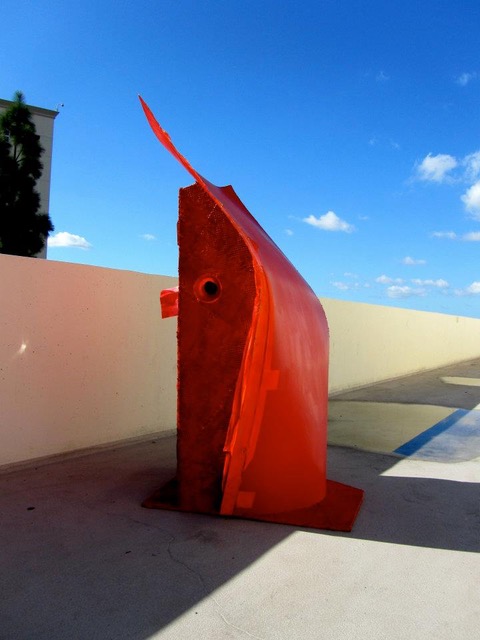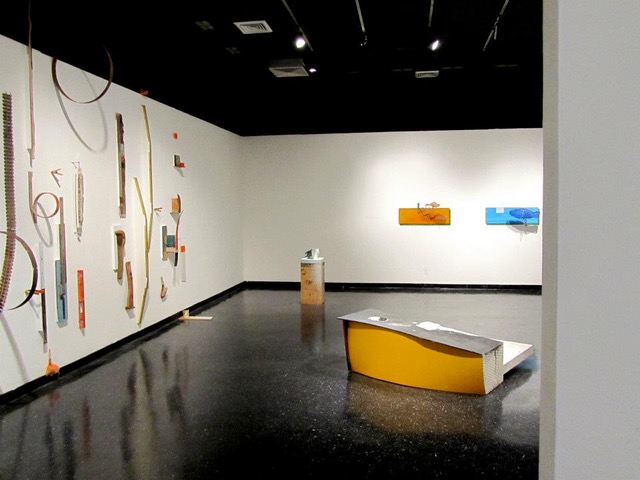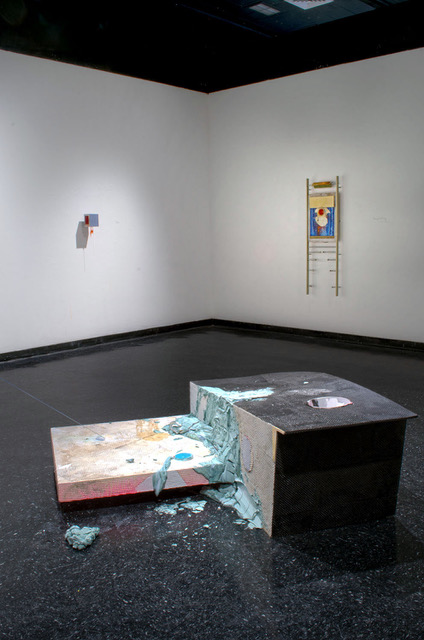






My Creations
My creations
My Creations
My creations

Musical Chairs
Musical chairs
Musical Chairs
Musical chairs
Interactive Musical Furniture
"Musical Chairs" is the development project explored in my dissertation research. The project stems from my previous work in embedded acoustic instruments and evolves the concept to explore embedded furniture, turning the home into a customizable performance space for interactive art. A kind of technological update to the old Romantic Salons. These instruments are designed as practical living room furniture, but are fabricated with sensors, processors, and audio drivers embedded within - making these fully functional, interactive musical instruments.
This project was most recently featured in the 20th anniversary festival for the New West Electro-Acoustic Music Organization (NWEAMO) in San Diego, California. It was involved in a large, audience participation meta-composition by Marcus Anomalous of Tulane University alongside multiple other interactive musical installations. Please visit https://soundcloud.com/xenonsound-misc/nweamo-metacomposition-2018 to listen to a binaural excerpt of this performance, recorded by David Pearl. To find out more about NWEAMO, visit nweamo.org
Coffee Table: Beech / Walnut, Copper nails
Coffee Table
The Coffee Table is inspired by the first embedded instrument designed by the maker. The Textural CrossFader is a two-keyboard instrument performed by selecting from a variety of sounds with one keyboard, determining the timbral quality of the sound, and pitch shift those sounds with the other keyboard, creating chords and melodies with the selected sonic texture.
In the same way, this table is performed by selecting up to five sounds with the further keyboard and pitch shifting those sounds with the nearer keyboard. The table is polyphonic, allowing for up to five pitches to be played simultaneously.
The table has six speakers spaced around the faces, as well as two subwoofers below; allowing for full-range, spatialized audio.
Wingback chair
The WingBack's synthesis is inspired by the Aeolian Chimes, one of my previous instruments, an electroacoustic wind chime. The chimes essentially functioned as regular wind chimes, but the clapper and bars were wrapped in copper tape, triggering an electronically synthesized sound when the wind caused them to touch.
Similarly, when the user taps on the right arm or the left stretcher, an additively synthesized chime is triggered. The cushions in this piece are pressure sensitive and change the quality of the chimes. Leaning left and right changes the fundamental frequency of the sound and rocking forward and back changes the oscillator’s waveform and the partial ratios.
The chair has speakers in the wings and in the base, allowing for vertical spatialization of the sound. It also uses a subwoofer in the base and bass shakers in the back. This allows for low frequencies to be felt, as well as heard by the user.
WingBack Chair: Beech / Walnut, Hemp fabric
End Table: Beech / Walnut, Touch screen
End Table
The End Table was the first experiment in this project. It set the design and material guidelines for the rest of the pieces that followed.
Touching the screen triggers the table’s synthesis. The XY coordinates of the touch points control the frequency and quality of the sound, with left/right controlling the frequency of the oscillator and forward/back controlling the oscillator’s waveform. The table is polyphonic and can detect up to 10 touch points.
There are also two photo-resistors embedded in the top. Blocking light from the left resistor adds distortion to the sound and blocking the right resistor increases a chorusing delay effect.
The table is a tenor/alto-range instrument and uses four speakers, one in each face allowing for full 360° spatialized audio.
Ottoman
The Ottoman's synthesis is based on a previous instrument designed by the maker. The JoyStyx is a small, cubic instrument with speakers spaced around its faces. It is performed by moving five video game joysticks, each controlling an independent granular synthesizer. The movements of the joysticks adjust the parameters of the synthesis, as well as spatialize the sound around the body of the instrument.
This ottoman is designed as a single joystick. The cushion is pressure sensitive and can measure how the user is sitting on it. Leaning forward to back and side to side allows you to use your full body as a joystick.
The ottoman is a tenor-range instrument and uses four speakers, one in each face. Moving around the cushion causes the sound to move around the ottoman.
Ottoman: Beech / Walnut, Hemp fabric

JoyStyx
Joystyx
JoyStyx
Joystyx
Spatialized polyphonic granulator
The "JoyStyx" is an embedded acoustic instrument that uses five video game joysticks to interact with a polyphonic granular synthesizer. The data from each joystick is serialized with an Arduino and mapped to parameters for grain-size, pitch-shift, scrubbing, and spatialization via a Pure Data patch running on a Raspberry Pi. So far, four of these instruments have been fabricated, each with a unique timbre and range to allow for ensemble performance. These instruments have three speakers, one mounted to the front and each of the side faces to allow for spatialized sound around the instrument. A larger speaker is mounted to the bottom face to boost the lower range of each instrument.
Granular Quartet is the first piece composed for this instrument. The piece is written for four JoyStyx, granulating samples of bassoon, bass clarinet, oboe, and flute respectively. The piece is composed as a slow progressing fugue and aimed to showcase a variety of the instruments' timbres and capabilities.
Granular Quartet, performed at LaTex 2016 hosted by UT Austin. Thank to Chase Mitchusson, Matthew Williams, Michael Blandino, and Anthony Marasco for their beautiful performance! Conducted by Dr. Christopher McCardle.
JoyStyx: Spruce, custom PCB, 3D-printed bassports. The custom PCB was designed in Fritzing and cleanly routes all joystick pins to an Arduino Micro to serialize and format data before sending it to the Raspberry Pi for processing.

AeolianWAVes
Aeolianwaves
AeolianWAVes
Aeolianwaves
Wind-Controlled Synthesizer
"AeolianWAVes" was a project I explored during my GA work with Dr. Edgar Berdahl. The project modernizes the traditional wind chime to allow the owner/maker to customize the chimes' timbres, and even compose unique works for the installation. This project explored making accessible DIY projects that could be designed into kit/instruction bundles distributed by sites such as Ponoko.
The body is digitally fabricated by cutting sheets of plywood or acrylic with a laser-cutter and holds all of the necessary components. Copper tape is connected to a Raspberry Pi's GPIO pins and, when any chime makes contact with the clapper, an additive-synthesized chime is triggered in a custom-made Pure Data patch. To see more or make your own, visit the project's Wiki page.

Textural CrossFader
textural crossfader
Textural CrossFader
textural crossfader
my first time
The "Textural CrossFader" is my first attempt at building an embedded acoustic instrument. This instrument uses two commercial keyboards, a Korg NanoKEY2 and a Keith McMillen QuNexus, to interact with a custom sample player programmed in Pure Data. Custom source sounds were sampled and uploaded to a Raspberry Pi. The Korg keyboard is used to select up to five sounds from the sample bank, while the QuNexus's aftertouch features are used to pitch-shift and crossfade between the selected samples. The QuNexus can activate up to five polyphonic voices that are randomly spatialized across the stereo field, allowing for complex, slowly morphing sonic textures.
A custom body was designed and digitally fabricated using a laser-cutter. This instrument was conceived as a tutorial to get myself familiar with the process of designing and building an embedded acoustic instrument from the bottom up. This design follows in the tradition of the Lap Boxes, created by Dr. Edgar Berdahl.

Collaborations
Collaborations
Collaborations
Collaborations
Social Interactions
After | Apple Box - Dr. Margaret Schedel
After | Apple Box is a work composed by my friend and former professor, Dr. Margaret Schedel, and was written in memory of her father. The piece repurposes old ammunition crates that belonged to her father and uses them as a performance interface for the work dedicated to him. As the title suggests, After | Apple Box draws inspiration from Pauline Oliveros's Apple Box Orchestra, and encourages performers to think of a passed loved one and record sounds that are meaningful to that relationship. The piece is then performed by triggering and manipulating these sounds with the ammunition crate.
In this collaboration, I designed a custom filtered piezo circuit attached to the ammunition boxes, as well as a Max/MSP patch to process the box's resonances. This resonance data is then sent to a machine learning model made in Wekinator that calculates the position where the box was tapped, allowing the boxes to be used as an expressive performance interface.
Cyclops puppet test, at La Mama in Manhattan.
Are they edible? - Jeanette oi-suk yew
Are They Edible is one of the fantastic puppetry projects by Jeanette Oi-Suk Yew. The multi-sensory work was an interpretation of Homer's Odyssey enacted by puppets, in which the audience was guided through the narrative and encouraged to dine upon edible pieces of the stage to engage them in a tactile interaction with the story's morals.
In this project I designed a light puppet representing the Cyclops of Homer's narrative. The puppet used finger/hand movements, read by a LEAP Motion camera interface, to control fading lights that were controlled by a Max/MSP patch mapping the LEAP data to a DMX lighting protocol that controlled each bulb's brightness.
sea porch - aren skalman
Sea Porch is a project Aren Skalman created for his Masters exhibition at San Diego State University. Aren creates multi-sensory work combining sculpture and sound. This piece consisted of two sculptures--one placed in the gallery and the other in the entry way--with microphones and speakers embedded within. The sound design captured local sounds from around each sculpture, vocoded them, and transmitted them to the other installation, creating a subtle dialog between the two works and between audience members in different physical spaces.
In this project I created the sound design and overall composition of the samples. I also created the Max/MSP patch that controlled the vocoder and open-sound-control transmission between the two sculptures.




